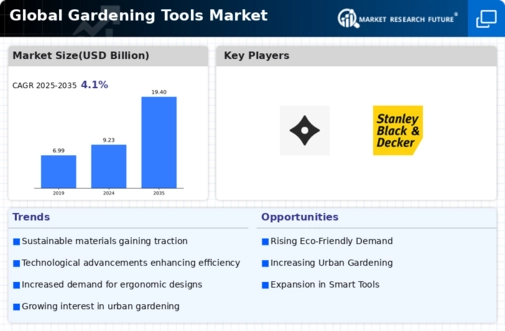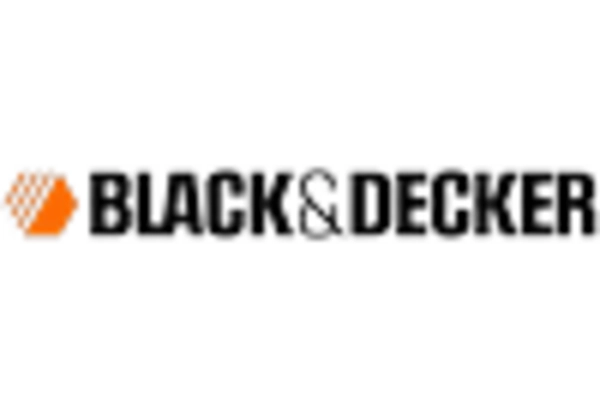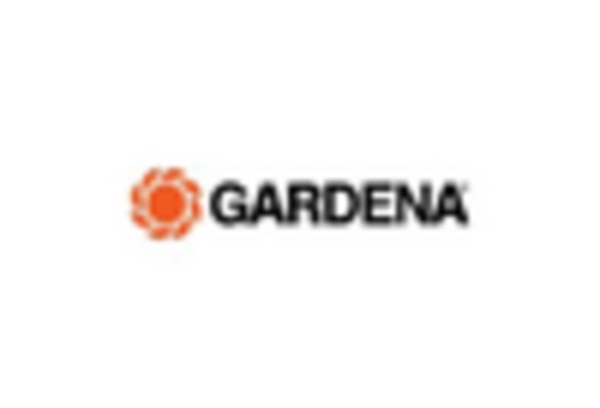-
EXECUTIVE SUMMARY 20
-
MARKET ATTRACTIVENESS ANALYSIS 22
- GLOBAL GARDENING TOOLS MARKET, BY PRODUCT TYPE 23
- GLOBAL GARDENING TOOLS MARKET, BY END USE 24
- GLOBAL GARDENING TOOLS MARKET, BY TOOL HOLDER 25
- GLOBAL GARDENING TOOLS MARKET, BY DISTRIBUTION CHANNEL 26
- GLOBAL GARDENING TOOLS MARKET, BY REGION 27
-
MARKET INTRODUCTION 28
-
SCOPE OF THE STUDY 28
-
RESEARCH OBJECTIVE 28
-
MARKET STRUCTURE 28
-
KEY BUYING CRITERIA 29
-
RESEARCH METHODOLOGY 30
-
RESEARCH PROCESS 30
-
PRIMARY RESEARCH 31
-
SECONDARY RESEARCH 32
-
MARKET SIZE ESTIMATION 33
-
FORECAST MODEL 34
-
LIST OF ASSUMPTIONS & LIMITATIONS 34
-
MARKET INSIGHTS 35
-
MARKET DYNAMICS 38
-
INTRODUCTION 38
-
DRIVERS 39
- GROWING TREND OF GARDENING ACTIVITIES 39
- GROWTH OF THE REAL ESTATE INDUSTRY 39
- RISING DEMAND FOR TECHNOLOGICALLY ADVANCED GARDENING TOOLS 39
- DRIVERS IMPACT ANALYSIS 40
-
RESTRAINT 40
- HIGH MAINTENANCE ASSOCIATED WITH GARDENING TOOLS 40
- RESTRAINTS IMPACT ANALYSIS 41
-
OPPORTUNITIES 41
- INITIATIVES TOWARDS URBAN GREEN SPACES AND GREEN INFRASTRUCTURE 41
-
MARKET FACTOR ANALYSIS 42
-
PORTER’S FIVE FORCES MODEL 42
- THREAT OF NEW ENTRANTS 42
- BARGAINING POWER OF SUPPLIERS 43
- THREAT OF SUBSTITUTES 43
- BARGAINING POWER OF BUYERS 43
- INTENSITY OF RIVALRY 43
-
SUPPLY CHAIN ANALYSIS 44
-
IMPACT OF THE COVID-19 OUTBREAK ON THE GLOBAL GARDENING TOOLS MARKET 45
- IMPACT ON GARDENING ACTIVITIES 45
- IMPACT ON SUPPLY CHAIN 45
- IMPACT ON RAW MATERIALS 45
- IMPACT ON CONSUMER BUYING BEHAVIOR 46
- IMPACT ON PRICE 46
- CASH FLOW CONSTRAINTS 46
-
ADDITIONAL REQUREMENT 46
-
GLOBAL GARDENING TOOLS MARKET, BY PRODUCT TYPE 47
-
OVERVIEW 47
- GLOBAL GARDENING TOOLS MARKET ESTIMATES & FORECAST, BY PRODUCT TYPE, 2020–2027 48
- GLOBAL GARDENING TOOLS MARKET ESTIMATES & FORECAST, BY PRODUCT TYPE, 2020–2027 48
-
LAWN MOWERS 49
- LAWN MOWERS: MARKET ESTIMATES & FORECAST, BY REGION, 2020–2027 49
-
BLOWERS 49
- BLOWERS: MARKET ESTIMATES & FORECAST, BY REGION, 2020–2027 50
-
VACUUMS & SWEEPERS 50
- VACUUMS & SWEEPERS: MARKET ESTIMATES & FORECAST, BY REGION, 2020–2027 50
-
PRUNING TOOLS 51
- PRUNING TOOLS: MARKET ESTIMATES & FORECAST, BY REGION, 2020–2027 51
-
STRIKING & DIGGING TOOLS 51
- STRIKING & DIGGING TOOLS: MARKET ESTIMATES & FORECAST, BY REGION, 2020–2027 52
-
CHAIN SAW 52
- CHAIN SAW: MARKET ESTIMATES & FORECAST, BY REGION, 2020–2027 52
-
OTHERS 53
- OTHERS: MARKET ESTIMATES & FORECAST, BY REGION, 2020–2027 53
-
GLOBAL GARDENING TOOLS MARKET, BY TOOL HOLDER 54
-
OVERVIEW 54
- GLOBAL GARDENING TOOLS MARKET ESTIMATES & FORECAST, BY TOOL HOLDER, 2020–2027 55
- GLOBAL GARDENING TOOLS MARKET ESTIMATES & FORECAST, BY TOOL HOLDER, 2020–2027 55
-
ENGINE TOOLS 56
- ENGINE TOOLS: MARKET ESTIMATES & FORECAST, BY REGION, 2020–2027 56
-
HAND TOOLS 56
- HAND TOOLS: MARKET ESTIMATES & FORECAST, BY REGION, 2020–2027 57
-
GLOBAL GARDENING TOOLS MARKET, BY END USE 58
-
OVERVIEW 58
- GLOBAL GARDENING TOOLS MARKET ESTIMATES & FORECAST, BY END USE, 2020–2027 59
- GLOBAL GARDENING TOOLS MARKET ESTIMATES & FORECAST, BY END USE, 2020–2027 59
-
RESIDENTIAL 59
- RESIDENTIAL: MARKET ESTIMATES & FORECAST, BY REGION, 2020–2027 60
-
COMMERCIAL 60
- COMMERCIAL: MARKET ESTIMATES & FORECAST, BY REGION, 2020–2027 60
-
GLOBAL GARDENING TOOLS MARKET, BY DISTRIBUTION CHANNEL 61
-
OVERVIEW 61
- GLOBAL GARDENING TOOLS MARKET ESTIMATES & FORECAST, BY DISTRIBUTION CHANNEL, 2020–2027 62
- GLOBAL GARDENING TOOLS MARKET ESTIMATES & FORECAST, BY DISTRIBUTION CHANNEL, 2020–2027 62
-
STORE BASED 63
- STORE BASED: MARKET ESTIMATES & FORECAST, BY REGION, 2020–2027 63
-
NON-STORE BASED 63
- NON-STORE BASED: MARKET ESTIMATES & FORECAST, BY REGION, 2020–2027 63
-
GLOBAL GARDENING TOOLS MARKET, BY REGION 64
-
OVERVIEW 64
- GLOBAL GARDENING TOOLS MARKET ESTIMATES & FORECAST, BY REGION, 2020–2027 65
- GLOBAL GARDENING TOOLS MARKET ESTIMATES & FORECAST, BY REGION, 2020–2027 66
-
NORTH AMERICA 67
- NORTH AMERICA GARDENING TOOLS MARKET ESTIMATES & FORECAST, BY COUNTRY, 2020–2027 67
- NORTH AMERICA GARDENING TOOLS MARKET ESTIMATES & FORECAST, BY COUNTRY, 2020–2027 68
- US 71
- CANADA 73
- MEXICO 76
-
EUROPE 80
- EUROPE GARDENING TOOLS MARKET ESTIMATES & FORECAST, BY COUNTRY, 2020–2027 81
- EUROPE GARDENING TOOLS MARKET ESTIMATES & FORECAST, BY COUNTRY, 2020–2027 81
- GERMANY 84
- UK 87
- FRANCE 90
- SPAIN 93
- ITALY 96
- SWEDEN 99
- NETHERLANDS 102
- BELGIUM 105
- SWITZERLAND 108
- POLAND 111
- REST OF EUROPE 114
-
ASIA-PACIFIC 118
- ASIA-PACIFIC GARDENING TOOLS MARKET ESTIMATES & FORECAST, BY COUNTRY, 2020–2027 118
- ASIA-PACIFIC GARDENING TOOLS MARKET ESTIMATES & FORECAST, BY COUNTRY, 2020–2027 119
- CHINA 122
- JAPAN 125
- INDIA 128
- AUSTRALIA & NEW ZEALAND 131
- REST OF ASIA-PACIFIC 134
-
SOUTH AMERICA 138
- SOUTH AMERICA GARDENING TOOLS MARKET ESTIMATES & FORECAST, BY COUNTRY, 2020–2027 138
- SOUTH AMERICA GARDENING TOOLS MARKET ESTIMATES & FORECAST, BY COUNTRY, 2020–2027 139
- BRAZIL 142
- ARGENTINA 144
- COLOMBIA 147
- REST OF SOUTH AMERICA 150
-
MIDDLE EAST & AFRICA 154
- MIDDLE EAST & AFRICA GARDENING TOOLS MARKET ESTIMATES & FORECAST, BY COUNTRY, 2020–2027 154
- MIDDLE EAST & AFRICA GARDENING TOOLS MARKET ESTIMATES & FORECAST, BY COUNTRY, 2020–2027 155
- GCC COUNTRIES 158
- SOUTH AFRICA 161
- NIGERIA 164
- EGYPT 167
- ALGERIA 170
- REST OF MIDDLE EAST & AFRICA 173
-
COMPETITIVE LANDSCAPE 177
-
INTRODUCTION 177
- MARKET STRATEGY ANALYSIS 177
-
KEY DEVELOPMENTS & GROWTH STRATEGIES 178
- PARTNERSHIP 178
- ACQUISITION 179
-
COMPANY PROFILES 180
-
FISKARS GROUP 180
- COMPANY OVERVIEW 180
- FINANCIAL OVERVIEW 181
- PRODUCTS OFFERED 181
- KEY DEVELOPMENTS 185
- SWOT ANALYSIS 185
- KEY STRATEGIES 185
-
HUSQVARNA AB 186
- COMPANY OVERVIEW 186
- FINANCIAL OVERVIEW 186
- PRODUCTS OFFERED 187
- KEY DEVELOPMENTS 191
- SWOT ANALYSIS 191
- KEY STRATEGIES 192
-
FALCON GARDEN TOOLS PVT. LTD 193
- COMPANY OVERVIEW 193
- FINANCIAL OVERVIEW 193
- PRODUCTS OFFERED 193
- KEY DEVELOPMENTS 194
- SWOT ANALYSIS 195
- KEY STRATEGIES 195
-
RIBE ENERGY MACHINERY SL 196
- COMPANY OVERVIEW 196
- FINANCIAL OVERVIEW 196
- PRODUCTS OFFERED 196
- KEY DEVELOPMENTS 197
- SWOT ANALYSIS 197
- KEY STRATEGIES 197
-
ILAGA SUPPLIES 198
- COMPANY OVERVIEW 198
- FINANCIAL OVERVIEW 198
- PRODUCTS OFFERED 198
- KEY DEVELOPMENTS 199
- SWOT ANALYSIS 200
- KEY STRATEGIES 200
-
STANLEY BLACK & DECKER, INC. 201
- COMPANY OVERVIEW 201
- FINANCIAL OVERVIEW 202
- PRODUCTS OFFERED 203
- KEY DEVELOPMENTS 206
- KEY STRATEGIES 207
-
INGERSOLL TILLAGE GROUP INC. 208
- COMPANY OVERVIEW 208
- FINANCIAL OVERVIEW 208
- PRODUCTS OFFERED 208
- KEY DEVELOPMENTS 210
- KEY STRATEGIES 210
-
BULLY TOOLS, INC. 211
- COMPANY OVERVIEW 211
- FINANCIAL OVERVIEW 211
- PRODUCTS OFFERED 211
- KEY DEVELOPMENTS 211
- KEY STRATEGIES 211
-
ZENPORT INDUSTRIES 212
- COMPANY OVERVIEW 212
- FINANCIAL OVERVIEW 212
- PRODUCTS OFFERED 212
- KEY DEVELOPMENTS 213
- KEY STRATEGIES 213
-
GRIFFON CORPORATION INC. 214
- COMPANY OVERVIEW 214
- FINANCIAL OVERVIEW 214
- PRODUCTS OFFERED 215
- KEY DEVELOPMENTS 215
- KEY STRATEGIES 215
-
APPENDIX 216
-
REFERENCES 216
-
RELATED REPORTS 216
-
-
LIST OF TABLES
-
PRIMARY INTERVIEWS 31
-
LIST OF ASSUMPTIONS & LIMITATIONS 34
-
GLOBAL GARDENING TOOLS MARKET ESTIMATES & FORECAST, BY PRODUCT TYPE, 2020–2027 (THOUSAND UNITS) 48
-
GLOBAL GARDENING TOOLS MARKET ESTIMATES & FORECAST, BY PRODUCT TYPE, 2020–2027 (USD MILLION) 48
-
LAWN MOWERS: MARKET ESTIMATES & FORECAST, BY REGION, 2020–2027 (USD MILLION) 49
-
BLOWERS: MARKET ESTIMATES & FORECAST, BY REGION, 2020–2027 (USD MILLION) 50
-
VACUUMS & SWEEPERS: MARKET ESTIMATES & FORECAST, BY REGION, 2020–2027 (USD MILLION) 50
-
PRUNING TOOLS: MARKET ESTIMATES & FORECAST, BY REGION, 2020–2027 (USD MILLION) 51
-
STRIKING & DIGGING TOOLS: MARKET ESTIMATES & FORECAST, BY REGION, 2020–2027 (USD MILLION) 52
-
CHAIN SAW: MARKET ESTIMATES & FORECAST, BY REGION, 2020–2027 (USD MILLION) 52
-
OTHERS: MARKET ESTIMATES & FORECAST, BY REGION, 2020–2027 (USD MILLION) 53
-
GLOBAL GARDENING TOOLS MARKET ESTIMATES & FORECAST, BY TOOL HOLDER, 2020–2027 (THOUSAND UNITS) 55
-
GLOBAL GARDENING TOOLS MARKET ESTIMATES & FORECAST, BY TOOL HOLDER, 2020–2027 (USD MILLION) 55
-
GLOBAL GARDENING TOOLS MARKET ESTIMATES & FORECAST, BY TOOL HOLDER, 2020–2027 (USD MILLION) 55
-
ENGINE TOOLS: MARKET ESTIMATES & FORECAST, BY REGION, 2020–2027 (USD MILLION) 56
-
HAND TOOLS: MARKET ESTIMATES & FORECAST, BY REGION, 2020–2027 (USD MILLION) 57
-
GLOBAL GARDENING TOOLS MARKET ESTIMATES & FORECAST, BY END USE, 2020–2027 (THOUSAND UNITS) 59
-
GLOBAL GARDENING TOOLS MARKET ESTIMATES & FORECAST, BY END USE, 2020–2027 (USD MILLION) 59
-
RESIDENTIAL: MARKET ESTIMATES & FORECAST, BY REGION, 2020–2027 (USD MILLION) 60
-
COMMERCIAL: MARKET ESTIMATES & FORECAST, BY REGION, 2020–2027 (USD MILLION) 60
-
GLOBAL GARDENING TOOLS MARKET ESTIMATES & FORECAST, BY DISTRIBUTION CHANNEL, 2020–2027 (THOUSAND UNITS) 62
-
GLOBAL GARDENING TOOLS MARKET ESTIMATES & FORECAST, BY DISTRIBUTION CHANNEL, 2020–2027 (USD MILLION) 62
-
STORE BASED: MARKET ESTIMATES & FORECAST, BY REGION, 2020–2027 (USD MILLION) 63
-
NON-STORE BASED: MARKET ESTIMATES & FORECAST, BY REGION, 2020–2027 (USD MILLION) 63
-
GLOBAL GARDENING TOOLS MARKET ESTIMATES & FORECAST, BY REGION, 2020–2027 (THOUSAND UNITS) 65
-
GLOBAL GARDENING TOOLS MARKET ESTIMATES & FORECAST, BY REGION, 2020–2027 (USD MILLION) 66
-
NORTH AMERICA: MARKET ESTIMATES & FORECAST, BY COUNTRY, 2020–2027 (THOUSAND UNITS) 67
-
NORTH AMERICA: MARKET ESTIMATES & FORECAST, BY COUNTRY, 2020–2027 (USD MILLION) 68
-
NORTH AMERICA: MARKET ESTIMATES, BY PRODUCT TYPE, 2020–2027 (THOUSAND UNITS) 68
-
NORTH AMERICA: MARKET ESTIMATES, BY PRODUCT TYPE, 2020–2027 (USD MILLION) 68
-
NORTH AMERICA: MARKET ESTIMATES, BY TOOL HOLDER, 2020–2027 (THOUSAND UNITS) 69
-
NORTH AMERICA: MARKET ESTIMATES, BY TOOL HOLDER, 2020–2027 (USD MILLION) 69
-
NORTH AMERICA: MARKET ESTIMATES, BY END USE, 2020–2027 (THOUSAND UNITS) 69
-
NORTH AMERICA: MARKET ESTIMATES, BY END USE, 2020–2027 (USD MILLION) 69
-
NORTH AMERICA: MARKET ESTIMATES, BY DISTRIBUTION CHANNEL, 2020–2027 (THOUSAND UNITS) 70
-
NORTH AMERICA: MARKET ESTIMATES, BY DISTRIBUTION CHANNEL, 2020–2027 (USD MILLION) 70
-
US: MARKET ESTIMATES, BY PRODUCT TYPE, 2020–2027 (THOUSAND UNITS) 71
-
US: MARKET ESTIMATES, BY PRODUCT TYPE, 2020–2027 (USD MILLION) 71
-
US: MARKET ESTIMATES, BY TOOL HOLDER, 2020–2027 (THOUSAND UNITS) 71
-
US: MARKET ESTIMATES, BY TOOL HOLDER, 2020–2027 (USD MILLION) 72
-
US: MARKET ESTIMATES, BY END USE, 2020–2027 (THOUSAND UNITS) 72
-
US: MARKET ESTIMATES, BY END USE, 2020–2027 (USD MILLION) 72
-
US: MARKET ESTIMATES, BY DISTRIBUTION CHANNEL, 2020–2027 (THOUSAND UNITS) 72
-
US: MARKET ESTIMATES, BY DISTRIBUTION CHANNEL, 2020–2027 (USD MILLION) 73
-
CANADA: MARKET ESTIMATES, BY PRODUCT TYPE, 2020–2027 (THOUSAND UNITS) 73
-
CANADA: MARKET ESTIMATES, BY PRODUCT TYPE, 2020–2027 (USD MILLION) 74
-
CANADA: MARKET ESTIMATES, BY TOOL HOLDER, 2020–2027 (THOUSAND UNITS) 74
-
CANADA: MARKET ESTIMATES, BY TOOL HOLDER, 2020–2027 (USD MILLION) 74
-
CANADA: MARKET ESTIMATES, BY END USE, 2020–2027 (THOUSAND UNITS) 75
-
CANADA: MARKET ESTIMATES, BY END USE, 2020–2027 (USD MILLION) 75
-
CANADA: MARKET ESTIMATES, BY DISTRIBUTION CHANNEL, 2020–2027 (THOUSAND UNITS) 75
-
CANADA: MARKET ESTIMATES, BY DISTRIBUTION CHANNEL, 2020–2027 (USD MILLION) 76
-
MEXICO: MARKET ESTIMATES, BY PRODUCT TYPE, 2020–2027 (THOUSAND UNITS) 76
-
MEXICO: MARKET ESTIMATES, BY PRODUCT TYPE, 2020–2027 (USD MILLION) 77
-
MEXICO: MARKET ESTIMATES, BY TOOL HOLDER, 2020–2027 (THOUSAND UNITS) 77
-
MEXICO: MARKET ESTIMATES, BY TOOL HOLDER, 2020–2027 (USD MILLION) 77
-
MEXICO: MARKET ESTIMATES, BY END USE, 2020–2027 (THOUSAND UNITS) 78
-
MEXICO: MARKET ESTIMATES, BY END USE, 2020–2027 (USD MILLION) 78
-
MEXICO: MARKET ESTIMATES, BY DISTRIBUTION CHANNEL, 2020–2027 (THOUSAND UNITS) 78
-
MEXICO: MARKET ESTIMATES, BY DISTRIBUTION CHANNEL, 2020–2027 (USD MILLION) 79
-
EUROPE: MARKET ESTIMATES & FORECAST, BY COUNTRY, 2020–2027 (THOUSAND UNITS) 81
-
EUROPE: MARKET ESTIMATES & FORECAST, BY COUNTRY, 2020–2027 (USD MILLION) 81
-
EUROPE: MARKET ESTIMATES, BY PRODUCT TYPE, 2020–2027 (THOUSAND UNITS) 82
-
EUROPE: MARKET ESTIMATES, BY PRODUCT TYPE, 2020–2027 (USD MILLION) 82
-
EUROPE: MARKET ESTIMATES, BY TOOL HOLDER, 2020–2027 (THOUSAND UNITS) 82
-
EUROPE: MARKET ESTIMATES, BY TOOL HOLDER, 2020–2027 (USD MILLION) 83
-
EUROPE: MARKET ESTIMATES, BY END USE, 2020–2027 (THOUSAND UNITS) 83
-
EUROPE: MARKET ESTIMATES, BY END USE, 2020–2027 (USD MILLION) 83
-
EUROPE: MARKET ESTIMATES, BY DISTRIBUTION CHANNEL, 2020–2027 (THOUSAND UNITS) 83
-
EUROPE: MARKET ESTIMATES, BY DISTRIBUTION CHANNEL, 2020–2027 (USD MILLION) 84
-
GERMANY: MARKET ESTIMATES, BY PRODUCT TYPE, 2020–2027 (THOUSAND UNITS) 84
-
GERMANY: MARKET ESTIMATES, BY PRODUCT TYPE, 2020–2027 (USD MILLION) 85
-
GERMANY: MARKET ESTIMATES, BY TOOL HOLDER, 2020–2027 (THOUSAND UNITS) 85
-
GERMANY: MARKET ESTIMATES, BY TOOL HOLDER, 2020–2027 (USD MILLION) 85
-
GERMANY: MARKET ESTIMATES, BY END USE, 2020–2027 (THOUSAND UNITS) 86
-
GERMANY: MARKET ESTIMATES, BY END USE, 2020–2027 (USD MILLION) 86
-
GERMANY: MARKET ESTIMATES, BY DISTRIBUTION CHANNEL, 2020–2027 (THOUSAND UNITS) 86
-
GERMANY: MARKET ESTIMATES, BY DISTRIBUTION CHANNEL, 2020–2027 (USD MILLION) 87
-
UK: MARKET ESTIMATES, BY PRODUCT TYPE, 2020–2027 (THOUSAND UNITS) 87
-
UK: MARKET ESTIMATES, BY PRODUCT TYPE, 2020–2027 (USD MILLION) 88
-
UK: MARKET ESTIMATES, BY TOOL HOLDER, 2020–2027 (THOUSAND UNITS) 88
-
UK: MARKET ESTIMATES, BY TOOL HOLDER, 2020–2027 (USD MILLION) 88
-
UK: MARKET ESTIMATES, BY END USE, 2020–2027 (THOUSAND UNITS) 89
-
UK: MARKET ESTIMATES, BY END USE, 2020–2027 (USD MILLION) 89
-
UK: MARKET ESTIMATES, BY DISTRIBUTION CHANNEL, 2020–2027 (THOUSAND UNITS) 89
-
UK: MARKET ESTIMATES, BY DISTRIBUTION CHANNEL, 2020–2027 (USD MILLION) 90
-
FRANCE: MARKET ESTIMATES, BY PRODUCT TYPE, 2020–2027 (THOUSAND UNITS) 90
-
FRANCE: MARKET ESTIMATES, BY PRODUCT TYPE, 2020–2027 (USD MILLION) 91
-
FRANCE: MARKET ESTIMATES, BY TOOL HOLDER, 2020–2027 (THOUSAND UNITS) 91
-
FRANCE: MARKET ESTIMATES, BY TOOL HOLDER, 2020–2027 (USD MILLION) 91
-
FRANCE: MARKET ESTIMATES, BY END USE, 2020–2027 (THOUSAND UNITS) 92
-
FRANCE: MARKET ESTIMATES, BY END USE, 2020–2027 (USD MILLION) 92
-
FRANCE: MARKET ESTIMATES, BY DISTRIBUTION CHANNEL, 2020–2027 (THOUSAND UNITS) 92
-
FRANCE: MARKET ESTIMATES, BY DISTRIBUTION CHANNEL, 2020–2027 (USD MILLION) 93
-
SPAIN: MARKET ESTIMATES, BY PRODUCT TYPE, 2020–2027 (THOUSAND UNITS) 93
-
SPAIN: MARKET ESTIMATES, BY PRODUCT TYPE, 2020–2027 (USD MILLION) 94
-
SPAIN: MARKET ESTIMATES, BY TOOL HOLDER, 2020–2027 (THOUSAND UNITS) 94
-
SPAIN: MARKET ESTIMATES, BY TOOL HOLDER, 2020–2027 (USD MILLION) 94
-
SPAIN: MARKET ESTIMATES, BY END USE, 2020–2027 (THOUSAND UNITS) 95
-
SPAIN: MARKET ESTIMATES, BY END USE, 2020–2027 (USD MILLION) 95
-
SPAIN: MARKET ESTIMATES, BY DISTRIBUTION CHANNEL, 2020–2027 (THOUSAND UNITS) 95
-
SPAIN: MARKET ESTIMATES, BY DISTRIBUTION CHANNEL, 2020–2027 (USD MILLION) 96
-
ITALY: MARKET ESTIMATES, BY PRODUCT TYPE, 2020–2027 (THOUSAND UNITS) 96
-
ITALY: MARKET ESTIMATES, BY PRODUCT TYPE, 2020–2027 (USD MILLION) 97
-
ITALY: MARKET ESTIMATES, BY TOOL HOLDER, 2020–2027 (THOUSAND UNITS) 97
-
ITALY: MARKET ESTIMATES, BY TOOL HOLDER, 2020–2027 (USD MILLION) 97
-
ITALY: MARKET ESTIMATES, BY END USE, 2020–2027 (THOUSAND UNITS) 98
-
ITALY: MARKET ESTIMATES, BY END USE, 2020–2027 (USD MILLION) 98
-
ITALY: MARKET ESTIMATES, BY DISTRIBUTION CHANNEL, 2020–2027 (THOUSAND UNITS) 98
-
ITALY: MARKET ESTIMATES, BY DISTRIBUTION CHANNEL, 2020–2027 (USD MILLION) 99
-
SWEDEN: MARKET ESTIMATES, BY PRODUCT TYPE, 2020–2027 (THOUSAND UNITS) 99
-
SWEDEN: MARKET ESTIMATES, BY PRODUCT TYPE, 2020–2027 (USD MILLION) 100
-
SWEDEN: MARKET ESTIMATES, BY TOOL HOLDER, 2020–2027 (THOUSAND UNITS) 100
-
SWEDEN: MARKET ESTIMATES, BY TOOL HOLDER, 2020–2027 (USD MILLION) 100
-
SWEDEN: MARKET ESTIMATES, BY END USE, 2020–2027 (THOUSAND UNITS) 101
-
SWEDEN: MARKET ESTIMATES, BY END USE, 2020–2027 (USD MILLION) 101
-
SWEDEN: MARKET ESTIMATES, BY DISTRIBUTION CHANNEL, 2020–2027 (THOUSAND UNITS) 101
-
SWEDEN: MARKET ESTIMATES, BY DISTRIBUTION CHANNEL, 2020–2027 (USD MILLION) 102
-
NETHERLANDS: MARKET ESTIMATES, BY PRODUCT TYPE, 2020–2027 (THOUSAND UNITS) 102
-
NETHERLANDS: MARKET ESTIMATES, BY PRODUCT TYPE, 2020–2027 (USD MILLION) 103
-
NETHERLANDS: MARKET ESTIMATES, BY TOOL HOLDER, 2020–2027 (THOUSAND UNITS) 103
-
NETHERLANDS: MARKET ESTIMATES, BY TOOL HOLDER, 2020–2027 (USD MILLION) 103
-
NETHERLANDS: MARKET ESTIMATES, BY END USE, 2020–2027 (THOUSAND UNITS) 104
-
NETHERLANDS: MARKET ESTIMATES, BY END USE, 2020–2027 (USD MILLION) 104
-
NETHERLANDS: MARKET ESTIMATES, BY DISTRIBUTION CHANNEL, 2020–2027 (THOUSAND UNITS) 104
-
NETHERLANDS: MARKET ESTIMATES, BY DISTRIBUTION CHANNEL, 2020–2027 (USD MILLION) 105
-
BELGIUM: MARKET ESTIMATES, BY PRODUCT TYPE, 2020–2027 (THOUSAND UNITS) 105
-
BELGIUM: MARKET ESTIMATES, BY PRODUCT TYPE, 2020–2027 (USD MILLION) 106
-
BELGIUM: MARKET ESTIMATES, BY TOOL HOLDER, 2020–2027 (THOUSAND UNITS) 106
-
BELGIUM: MARKET ESTIMATES, BY TOOL HOLDER, 2020–2027 (USD MILLION) 106
-
BELGIUM: MARKET ESTIMATES, BY END USE, 2020–2027 (THOUSAND UNITS) 107
-
BELGIUM: MARKET ESTIMATES, BY END USE, 2020–2027 (USD MILLION) 107
-
BELGIUM: MARKET ESTIMATES, BY DISTRIBUTION CHANNEL, 2020–2027 (THOUSAND UNITS) 107
-
BELGIUM: MARKET ESTIMATES, BY DISTRIBUTION CHANNEL, 2020–2027 (USD MILLION) 108
-
SWITZERLAND: MARKET ESTIMATES, BY PRODUCT TYPE, 2020–2027 (THOUSAND UNITS) 108
-
SWITZERLAND: MARKET ESTIMATES, BY PRODUCT TYPE, 2020–2027 (USD MILLION) 109
-
SWITZERLAND: MARKET ESTIMATES, BY TOOL HOLDER, 2020–2027 (THOUSAND UNITS) 109
-
SWITZERLAND: MARKET ESTIMATES, BY TOOL HOLDER, 2020–2027 (USD MILLION) 109
-
SWITZERLAND: MARKET ESTIMATES, BY END USE, 2020–2027 (THOUSAND UNITS) 110
-
SWITZERLAND: MARKET ESTIMATES, BY END USE, 2020–2027 (USD MILLION) 110
-
SWITZERLAND: MARKET ESTIMATES, BY DISTRIBUTION CHANNEL, 2020–2027 (THOUSAND UNITS) 110
-
SWITZERLAND: MARKET ESTIMATES, BY DISTRIBUTION CHANNEL, 2020–2027 (USD MILLION) 111
-
POLAND: MARKET ESTIMATES, BY PRODUCT TYPE, 2020–2027 (THOUSAND UNITS) 111
-
POLAND: MARKET ESTIMATES, BY PRODUCT TYPE, 2020–2027 (USD MILLION) 112
-
POLAND: MARKET ESTIMATES, BY TOOL HOLDER, 2020–2027 (THOUSAND UNITS) 112
-
POLAND: MARKET ESTIMATES, BY TOOL HOLDER, 2020–2027 (USD MILLION) 112
-
POLAND: MARKET ESTIMATES, BY END USE, 2020–2027 (THOUSAND UNITS) 113
-
POLAND: MARKET ESTIMATES, BY END USE, 2020–2027 (USD MILLION) 113
-
POLAND: MARKET ESTIMATES, BY DISTRIBUTION CHANNEL, 2020–2027 (THOUSAND UNITS) 113
-
POLAND: MARKET ESTIMATES, BY DISTRIBUTION CHANNEL, 2020–2027 (USD MILLION) 114
-
REST OF EUROPE: MARKET ESTIMATES, BY PRODUCT TYPE, 2020–2027 (THOUSAND UNITS) 114
-
REST OF EUROPE: MARKET ESTIMATES, BY PRODUCT TYPE, 2020–2027 (USD MILLION) 115
-
REST OF EUROPE: MARKET ESTIMATES, BY TOOL HOLDER, 2020–2027 (THOUSAND UNITS) 115
-
REST OF EUROPE: MARKET ESTIMATES, BY TOOL HOLDER, 2020–2027 (USD MILLION) 115
-
REST OF EUROPE: MARKET ESTIMATES, BY END USE, 2020–2027 (THOUSAND UNITS) 116
-
REST OF EUROPE: MARKET ESTIMATES, BY END USE, 2020–2027 (USD MILLION) 116
-
REST OF EUROPE: MARKET ESTIMATES, BY DISTRIBUTION CHANNEL, 2020–2027 (THOUSAND UNITS) 116
-
REST OF EUROPE: MARKET ESTIMATES, BY DISTRIBUTION CHANNEL, 2020–2027 (USD MILLION) 117
-
ASIA-PACIFIC: MARKET ESTIMATES & FORECAST, BY COUNTRY, 2020–2027 (THOUSDAND UNITS) 118
-
ASIA-PACIFIC: MARKET ESTIMATES & FORECAST, BY COUNTRY, 2020–2027 (USD MILLION) 119
-
ASIA-PACIFIC: MARKET ESTIMATES, BY PRODUCT TYPE, 2020–2027 (THOUSAND UNITS) 119
-
ASIA-PACIFIC: MARKET ESTIMATES, BY PRODUCT TYPE, 2020–2027 (USD MILLION) 120
-
ASIA-PACIFIC: MARKET ESTIMATES, BY TOOL HOLDER, 2020–2027 (THOUSAND UNITS) 120
-
ASIA-PACIFIC: MARKET ESTIMATES, BY TOOL TYPE, 2020–2027 (USD MILLION) 120
-
ASIA-PACIFIC: MARKET ESTIMATES, BY END USE, 2020–2027 (THOUSAND UNITS) 121
-
ASIA-PACIFIC: MARKET ESTIMATES, BY END USE, 2020–2027 (USD MILLION) 121
-
ASIA-PACIFIC: MARKET ESTIMATES, BY DISTRIBUTION CHANNEL, 2020–2027 (THOUSAND UNITS) 121
-
ASIA-PACIFIC: MARKET ESTIMATES, BY DISTRIBUTION CHANNEL, 2020–2027 (USD MILLION) 122
-
CHINA: MARKET ESTIMATES, BY PRODUCT TYPE, 2020–2027 (THOUSAND UNITS) 122
-
CHINA: MARKET ESTIMATES, BY PRODUCT TYPE, 2020–2027 (USD MILLION) 123
-
CHINA: MARKET ESTIMATES, BY TOOL HOLDER, 2020–2027 (THOUSAND UNITS) 123
-
CHINA: MARKET ESTIMATES, BY TOOL TYPE, 2020–2027 (USD MILLION) 123
-
CHINA: MARKET ESTIMATES, BY END USE, 2020–2027 (THOUSAND UNITS) 124
-
CHINA: MARKET ESTIMATES, BY END USE, 2020–2027 (USD MILLION) 124
-
CHINA: MARKET ESTIMATES, BY DISTRIBUTION CHANNEL, 2020–2027 (THOUSAND UNITS) 124
-
CHINA: MARKET ESTIMATES, BY DISTRIBUTION CHANNEL, 2020–2027 (USD MILLION) 125
-
JAPAN: MARKET ESTIMATES, BY PRODUCT TYPE, 2020–2027 (THOUSAND UNITS) 125
-
JAPAN: MARKET ESTIMATES, BY PRODUCT TYPE, 2020–2027 (USD MILLION) 126
-
JAPAN: MARKET ESTIMATES, BY TOOL HOLDER, 2020–2027 (THOUSAND UNITS) 126
-
JAPAN: MARKET ESTIMATES, BY TOOL TYPE, 2020–2027 (USD MILLION) 126
-
JAPAN: MARKET ESTIMATES, BY END USE, 2020–2027 (THOUSAND UNITS) 127
-
JAPAN: MARKET ESTIMATES, BY END USE, 2020–2027 (USD MILLION) 127
-
JAPAN: MARKET ESTIMATES, BY DISTRIBUTION CHANNEL, 2020–2027 (THOUSAND UNITS) 127
-
JAPAN: MARKET ESTIMATES, BY DISTRIBUTION CHANNEL, 2020–2027 (USD MILLION) 128
-
INDIA: MARKET ESTIMATES, BY PRODUCT TYPE, 2020–2027 (THOUSAND UNITS) 128
-
INDIA: MARKET ESTIMATES, BY PRODUCT TYPE, 2020–2027 (USD MILLION) 129
-
INDIA: MARKET ESTIMATES, BY TOOL HOLDER, 2020–2027 (THOUSAND UNITS) 129
-
INDIA: MARKET ESTIMATES, BY TOOL TYPE, 2020–2027 (USD MILLION) 129
-
INDIA: MARKET ESTIMATES, BY END USE, 2020–2027 (THOUSAND UNITS) 130
-
INDIA: MARKET ESTIMATES, BY END USE, 2020–2027 (USD MILLION) 130
-
INDIA: MARKET ESTIMATES, BY DISTRIBUTION CHANNEL, 2020–2027 (THOUSAND UNITS) 130
-
INDIA: MARKET ESTIMATES, BY DISTRIBUTION CHANNEL, 2020–2027 (USD MILLION) 131
-
AUSTRALIA & NEW ZEALAND: MARKET ESTIMATES, BY PRODUCT TYPE, 2020–2027 (THOUSAND UNITS) 131
-
AUSTRALIA & NEW ZEALAND: MARKET ESTIMATES, BY PRODUCT TYPE, 2020–2027 (USD MILLION) 132
-
AUSTRALIA & NEW ZEALAND: MARKET ESTIMATES, BY TOOL HOLDER, 2020–2027 (THOUSAND UNITS) 132
-
AUSTRALIA & NEW ZEALAND: MARKET ESTIMATES, BY TOOL TYPE, 2020–2027 (USD MILLION) 132
-
AUSTRALIA & NEW ZEALAND: MARKET ESTIMATES, BY END USE, 2020–2027 (THOUSAND UNITS) 133
-
AUSTRALIA & NEW ZEALAND: MARKET ESTIMATES, BY END USE, 2020–2027 (USD MILLION) 133
-
AUSTRALIA & NEW ZEALAND: MARKET ESTIMATES, BY DISTRIBUTION CHANNEL, 2020–2027 (THOUSAND UNITS) 133
-
AUSTRALIA & NEW ZEALAND: MARKET ESTIMATES, BY DISTRIBUTION CHANNEL, 2020–2027 (USD MILLION) 134
-
REST OF ASIA-PACIFIC: MARKET ESTIMATES, BY PRODUCT TYPE, 2020–2027 (THOUSAND UNITS) 134
-
REST OF ASIA-PACIFIC: MARKET ESTIMATES, BY PRODUCT TYPE, 2020–2027 (USD MILLION) 135
-
REST OF ASIA-PACIFIC: MARKET ESTIMATES, BY TOOL HOLDER, 2020–2027 (THOUSAND UNITS) 135
-
REST OF ASIA-PACIFIC: MARKET ESTIMATES, BY TOOL TYPE, 2020–2027 (USD MILLION) 135
-
REST OF ASIA-PACIFIC: MARKET ESTIMATES, BY END USE, 2020–2027 (THOUSAND UNITS) 136
-
REST OF ASIA-PACIFIC: MARKET ESTIMATES, BY END USE, 2020–2027 (USD MILLION) 136
-
REST OF ASIA-PACIFIC: MARKET ESTIMATES, BY DISTRIBUTION CHANNEL, 2020–2027 (THOUSAND UNITS) 136
-
REST OF ASIA-PACIFIC: MARKET ESTIMATES, BY DISTRIBUTION CHANNEL, 2020–2027 (USD MILLION) 137
-
SOUTH AMERICA: MARKET ESTIMATES & FORECAST, BY COUNTRY, 2020–2027 (THOUSAND UNITS) 138
-
SOUTH AMERICA: MARKET ESTIMATES & FORECAST, BY COUNTRY, 2020–2027 (USD MILLION) 139
-
SOUTH AMERICA: MARKET ESTIMATES, BY PRODUCT TYPE, 2020–2027 (THOUSAND UNITS) 139
-
SOUTH AMERICA: MARKET ESTIMATES, BY PRODUCT TYPE, 2020–2027 (USD MILLION) 139
-
SOUTH AMERICA: MARKET ESTIMATES, BY TOOL HOLDER, 2020–2027 (THOUSAND UNITS) 140
-
SOUTH AMERICA: MARKET ESTIMATES, BY TOOL HOLDER, 2020–2027 (USD MILLION) 140
-
SOUTH AMERICA: MARKET ESTIMATES, BY END USE, 2020–2027 (THOUSAND UNITS) 140
-
SOUTH AMERICA: MARKET ESTIMATES, BY END USE, 2020–2027 (USD MILLION) 140
-
SOUTH AMERICA: MARKET ESTIMATES, BY DISTRIBUTION CHANNEL, 2020–2027 (THOUSAND UNITS) 141
-
SOUTH AMERICA: MARKET ESTIMATES, BY DISTRIBUTION CHANNEL, 2020–2027 (USD MILLION) 141
-
BRAZIL: MARKET ESTIMATES, BY PRODUCT TYPE, 2020–2027 (THOUSAND UNITS) 142
-
BRAZIL: MARKET ESTIMATES, BY PRODUCT TYPE, 2020–2027 (USD MILLION) 142
-
BRAZIL: MARKET ESTIMATES, BY TOOL HOLDER, 2020–2027 (THOUSAND UNITS) 142
-
BRAZIL: MARKET ESTIMATES, BY TOOL HOLDER, 2020–2027 (USD MILLION) 143
-
BRAZIL: MARKET ESTIMATES, BY END USE, 2020–2027 (THOUSAND UNITS) 143
-
BRAZIL: MARKET ESTIMATES, BY END USE, 2020–2027 (USD MILLION) 143
-
BRAZIL: MARKET ESTIMATES, BY DISTRIBUTION CHANNEL, 2020–2027 (THOUSAND UNITS) 143
-
BRAZIL: MARKET ESTIMATES, BY DISTRIBUTION CHANNEL, 2020–2027 (USD MILLION) 144
-
ARGENTINA: MARKET ESTIMATES, BY PRODUCT TYPE, 2020–2027 (THOUSAND UNITS) 144
-
ARGENTINA: MARKET ESTIMATES, BY PRODUCT TYPE, 2020–2027 (USD MILLION) 145
-
ARGENTINA: MARKET ESTIMATES, BY TOOL HOLDER, 2020–2027 (THOUSAND UNITS) 145
-
ARGENTINA: MARKET ESTIMATES, BY TOOL HOLDER, 2020–2027 (USD MILLION) 145
-
ARGENTINA: MARKET ESTIMATES, BY END USE, 2020–2027 (THOUSAND UNITS) 146
-
ARGENTINA: MARKET ESTIMATES, BY END USE, 2020–2027 (USD MILLION) 146
-
ARGENTINA: MARKET ESTIMATES, BY DISTRIBUTION CHANNEL, 2020–2027 (THOUSAND UNITS) 146
-
ARGENTINA: MARKET ESTIMATES, BY DISTRIBUTION CHANNEL, 2020–2027 (USD MILLION) 147
-
COLOMBIA: MARKET ESTIMATES, BY PRODUCT TYPE, 2020–2027 (THOUSAND UNITS) 147
-
COLOMBIA: MARKET ESTIMATES, BY PRODUCT TYPE, 2020–2027 (USD MILLION) 148
-
COLOMBIA: MARKET ESTIMATES, BY TOOL HOLDER, 2020–2027 (THOUSAND UNITS) 148
-
COLOMBIA: MARKET ESTIMATES, BY TOOL HOLDER, 2020–2027 (USD MILLION) 148
-
COLOMBIA: MARKET ESTIMATES, BY END USE, 2020–2027 (THOUSAND UNITS) 149
-
COLOMBIA: MARKET ESTIMATES, BY END USE, 2020&ndas









Leave a Comment